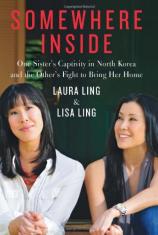Somewhere Inside: One Sister’s Captivity in North Korea and the Other’s Fight to Bring Her Home
Review
Somewhere Inside: One Sister’s Captivity in North Korea and the Other’s Fight to Bring Her Home
The title of this book may seem bland and unrevealing, but the
reader soon sees its double resonance. All her family knew for
almost five months was that Laura Ling was being held
“somewhere inside” the dark diplomatic hole that is
North Korea. Meanwhile, both she and her energetic sister, Lisa,
back home were drawing strength from “somewhere inside”
to survive and end her ordeal.
The affair made international headlines a year ago. Laura was
working on a television show about the plight of North Korean
defectors who risked everything to sneak across the border into
neighboring China. A local guide, who may or may not have been
betraying them, led her and two of her crew members across the
frozen Tumen River into North Korean territory, where they were
immediately pursued by border guards. Laura and her assistant, Euna
Lee, were actually back on the Chinese side when they were
apprehended, severely beaten, and dragged back across the ice into
captivity.
Laura and Lisa had one huge advantage not available to most
people: Both were savvy and highly successful television
journalists who had strong connections in both media and government
worlds. Al Gore was chairman of the television company for which
Laura worked, and Lisa had worked for Oprah Winfrey. Lisa’s
very first move on the home front was to enlist the help of ace
diplomat Richard Holbrooke, whom she characterizes as “my
friend.” Very shortly she was dealing with people like Hilary
Clinton and Bill Richardson. Not a bad defensive line in
anybody’s league.
Laura, held in relatively humane conditions thousands of miles
away, of course had only herself to rely on and only very sketchy
news of the “Free Laura” campaign back home. She could
receive letters and packages, but her movements were severely
restricted, she had health problems, and the only friendly outside
contact she had was through the Swedish ambassador, there being no
American diplomatic presence on the ground.
Inevitably hers is the more compelling of the two intertwined
narratives. She had a room to herself but was not allowed to get
near the windows and was severely restricted in where she could
walk when outside the building. When driven somewhere by car, she
had to keep her eyes closed and head down. She was questioned
relentlessly and subjected to endless barrages of anti-American
propaganda. Her keepers assured her that the American government
did not care about her fate. She and Euna Lee were subjected to a
show trial in which her “defense attorney” limited his
role to a plea for mercy. Laura was given a shockingly unjust
sentence of 12 years in a North Korean labor camp.
One of the timeless and fascinating aspects of this story is
how, in classic fashion, Laura bonded to some degree with her
guards, interrogators and translators. A kind of guarded intimacy,
perhaps even affection, developed in both directions. Even so,
Laura learned to be careful about everything she said, choosing
words designed not to offend her easily offended masters or worsen
her own situation.
The same was true on the home front, as Lisa’s campaign
gathered steam. Tensions were high between Washington and Pyongyang
over North Korea’s nuclear adventurism, and Washington had to
be super careful not to do or say anything that might make the
North Koreans angry. The North Koreans wanted both an apology and a
confession of evil intent from Laura, and they got both ---
reluctantly given for the sole purpose of getting Laura home. The
identity of the high-level US envoy who would be sent to bring
Laura home if she were pardoned was the subject of endlessly touchy
back-and-forth negotiations. Bill Clinton finally got the job,
which he performed with grace and cautious dignity. And, of course,
when the pardon finally came, Laura was compelled to write an
abject letter of thanks to Kim Jon Il, the “Dear
Leader” of North Korea.
The story here is told with understated eloquence and
illuminating detail. International politics and humble family
affairs are treated with equal seriousness. North Korea comes
across as a truly miserable place, its people utterly helpless in
the hands of a government they must worship even as it oppresses
them. If you ever get imprisoned there, somehow get in touch with
the Ling sisters. They have the clout to get you out.
Reviewed by Robert Finn (Robertfinn@aol.com) on January 23, 2011
Somewhere Inside: One Sister’s Captivity in North Korea and the Other’s Fight to Bring Her Home
- Publication Date: May 18, 2010
- Genres: Current Affairs, Nonfiction
- Hardcover: 322 pages
- Publisher: William Morrow
- ISBN-10: 0062000675
- ISBN-13: 9780062000675




